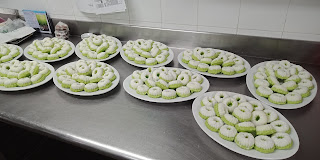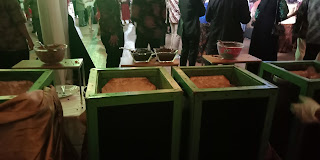WAFLE IRON
A
waffle iron is a utensil or appliance used to cook waffles. It usually consists
of two hinged metal plates, molded to create the honeycomb pattern found on
waffles. The iron is heated and either batter is poured or dough is placed
between the plates, which are then closed to bake the waffle.
History
The
earliest waffle irons originated in the Low Countries around the 14th century.
These waffle irons were constructed of two hinged iron plates connected to two
long, wooden handles. The plates were often made to imprint elaborate patterns
on the waffle, including coat of arms, landscapes, or religious symbols. The
waffles would be baked over the hearth fire.
In the
19th century, the waffle iron's design adapted to the increasingly common
kitchen stove. In 1869, American Cornelius Swartwout patented a waffle iron for
stovetop use consisting of cast-iron plates joined by a hinge that swiveled in
a cast-iron collar. In 1891 John Kleimbach, a German immigrant living in
Shamokin, Pennsylvania became a traveling salesman of waffles after fashioning
an iron for the Mansion House Hotel. Kliembach sold waffles for a penny each or
ten cents for a dozen. This was popular at the Chicago World's Fair.
In 1911,
General Electric produced a prototype electric waffle iron, although production
did not begin until around 1918. Later, as the waffle iron became more prevalent,
designers worked on making the appliance more attractive on the countertop.
How to Clean Up ?
How to clean the machine waffle
toaster is divided into two namely:
First Stage: Cleaning
the Inside / Section of Waffle Manggang
Remove the dough that
is still attached with a toothbrush soft or rubber spatula.
If there is a dough
that has been hard and hard to clean, how? Pour the vegetable oil on stubborn
dough and cook 2-3 minutes until the dough is softened and easy to clean. After
the dough softens, wipe with tissue paper.
Use paper towels dipped
in soapy water to clean all surfaces.
Take a towel / tissue
paper dipped in clean water to remove the soap. Do this several times to make
sure the soap is gone.
Use a dry towel /
tissue to wipe after the toaster. After making sure the inside is dry and
clean, it's time to go to stage 2.
If the toaster plates
can be removed, remove and wash in order to get a cleaner result.
Phase 2: Cleaning the
Exterior
Use a towel / wet tissue
paper to wipe the entire section outside. If greasy use soap water dye, wet
cloth to remove soap and dry cloth.
Make sure all parts of
the waffle grill machine have dried up when we distort back to the closet.
DISH WASHING
A sink also known by
other names including sinker, washbowl, hand basin and wash basin is a
bowl-shaped plumbing fixture used for washing hands, dishwashing, and other
purposes. Sinks have taps (faucets) that supply hot and cold water and may
include a spray feature to be used for faster rinsing. They also include a
drain to remove used water; this drain may itself include a strainer and/or
shut-off device and an overflow-prevention device. Sinks may also have an
integrated soap dispenser. Many sinks, especially in kitchens, are installed
adjacent to or inside a counter.
History
The washstand was a
bathroom sink made in the United States in the late 18th century. The
washstands were small tables on which were placed a pitcher and a deep bowl,
following the English tradition. Sometimes the table had a hole where the large
bowl rested, which led to the making of dry sinks. From about 1820 to 1900 the
dry sink evolved by the addition of a wooden cabinet with a trough built on the
top, lined with zinc or lead. This is where the bowls or buckets for water were
kept. Splashboards were sometimes added to the back wall, as well as shelves
and drawers, the more elaborate designs usually placed in the kitchen.
How to Clean Up ?
Tips on caring for the
dishwasher:
Check the shelves part
of the shelf rack in case there is dirt attached, if pepper clean with sponge
then rinse.
Avoid washing equipment
or objects containing oil, acids, rust, paint.
Do not open the
dishwasher when the machine is working.
For sharp and long
equipment such as a knife, preferably horizontally, and a sharp side facing up
or down, it is useful for the tool to be thoroughly cleaned into each part.
ICE MAKER MECHINE
An icemaker, ice
generator, or ice machine
may refer to either a consumer device for making ice,
found inside a home freezer; a stand-alone appliance for making ice, or an
industrial machine for making ice on a large scale. The term "ice
machine" usually refers to the stand-alone appliance.
The ice generator is
the part of the ice machine that actually produces the ice. This would include
the evaporator and any associated drives/controls/subframe that are directly
involved with making and ejecting the ice into storage. When most people refer
to an ice generator, they mean this ice-making subsystem alone, minus
refrigeration.
An ice machine,
however, particularly if described as 'packaged', would typically be a complete
machine including refrigeration, controls, and dispenser, requiring only
connection to power and water supplies.
The term icemaker is
more ambiguous, with some manufacturers describing their packaged ice machine
as an icemaker, while others describe their generators in this way.
How to Clean Up ?
By wiping clean parts
of parts and make sure the power has been removed so that it is cleaned more
easily by using ordinary cleaning soap.































